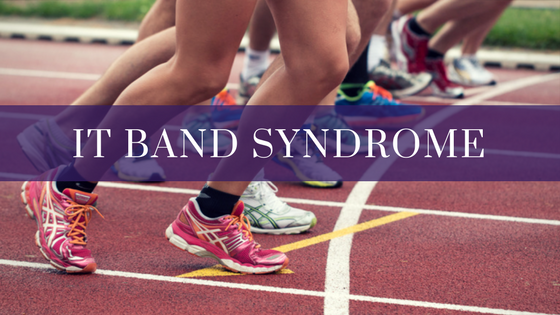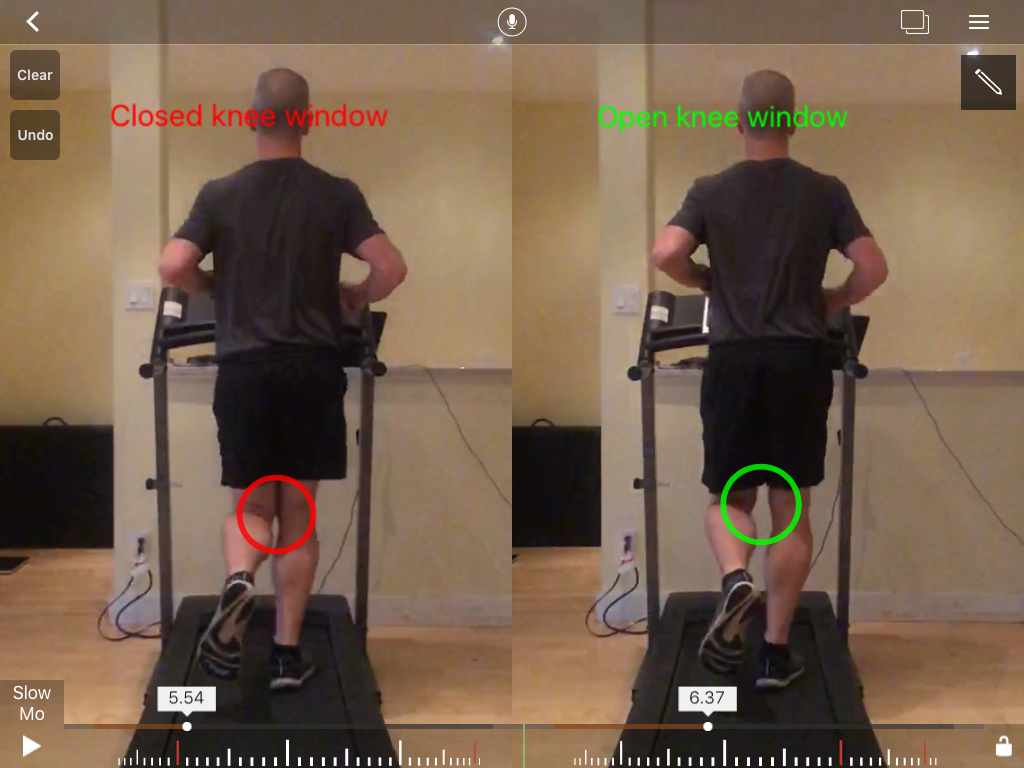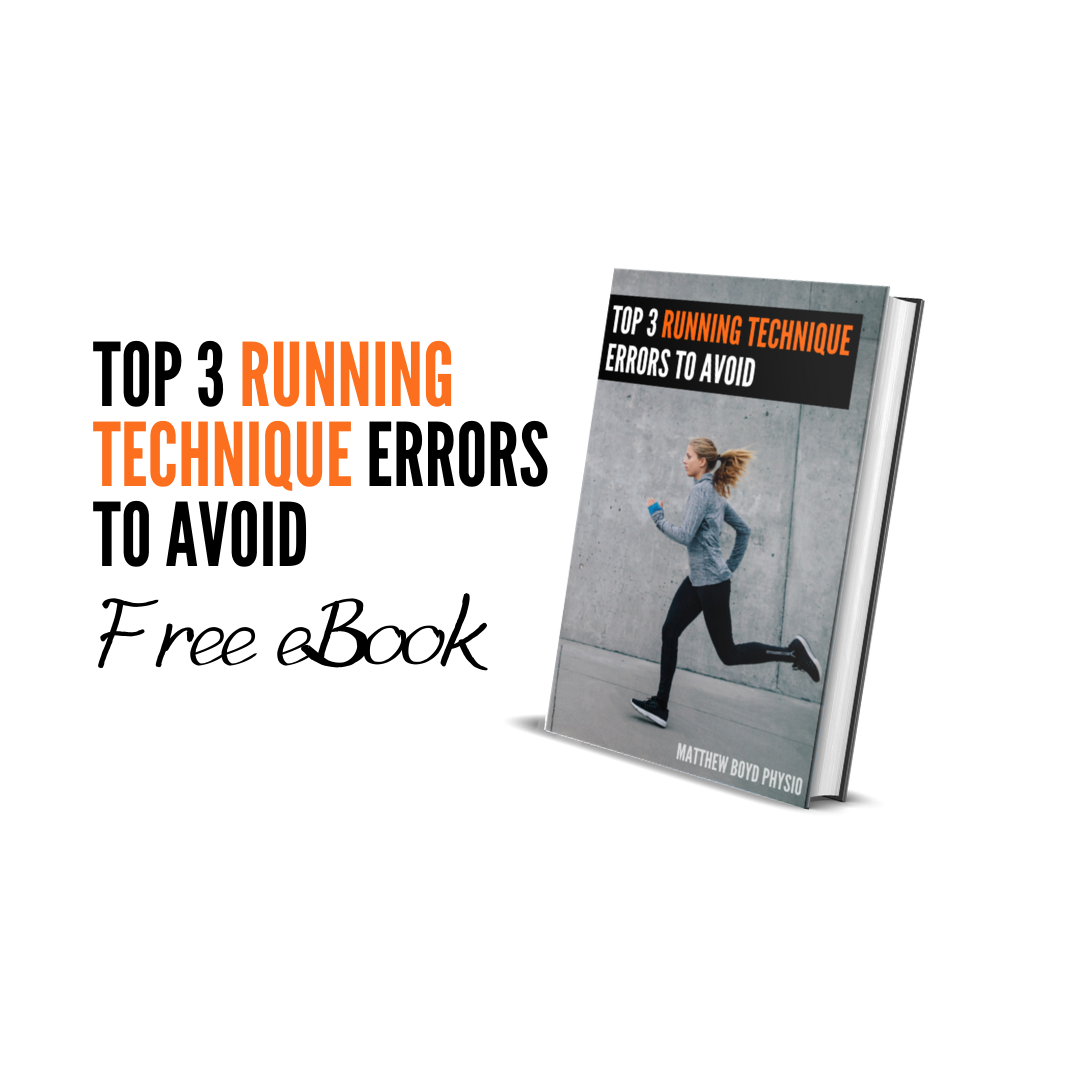
IT Band Syndrome is a sharp pain in the side of your knee. It is sometimes called Runner’s Knee but that term is usually more commonly used to refer to pain in the front of the knee known as patellofemoral pain syndrome. IT Band Syndrome pain is very much on the side of the knee and it usually comes on with running or cycling.

Where is the pain coming from?
The IT Band is a large band of connective tissue coming from the Gluteus Maximus and Tensor Fascia Latae muscles of the hip. The two muscles join together on the side of the leg and form the Iliotibial Band or IT Band. The IT Band is a large flat tract of connective tissue made of strong, ropey like fibres of collagen. It comes down the side of the thigh and attaches into the side of the tibia (shin bone). Being a very strong connective tissue at the side of the knee allows the IT Band to offer some lateral (side) stability to the knee joint.
The sharp pain at the side of the knee experienced with IT Band Syndrome is likely coming from the ITB where it inserts into the tibia or maybe some fatty tissue just underneath it that gets squished. The IT Band sits just in front of a bony outcrop of the femur (thigh bone) known as the lateral epicondyle. It was previously believed that the ITB would flick back and forth over that bony outcrop causing friction and so we had the term ITB Friction Syndrome (as I mention in the video above). Recently though, the idea that the ITB actually flicks back and forth has been challenged and it is now believed that it doesn’t (Fairclough 2006). Rather, it is now believed the ITB just gets squished up against the epicondyle as the knee bands. Now we think of IT Band Syndrome as more of a compressive problem.
Either way, we’re pretty sure it’s the ITB itself or some fatty tissue just underneath it that is being irritated and causing the pain.
Why do I have IT Band Syndrome?
To answer the question “Why do I have IT Band Syndrome” we need to understand what is happening in the tissues involved. As we discussed above, the pain is coming from the ITB itself just at the side of the knee or perhaps the fatty tissue just underneath it. So we have some IT Band made of collagen and some fatty stuff. Both of these things are tissues. Which is to say, they are both collections of similar living cells within the body that will respond to the stresses and loads placed upon them.
As you land when you run you bend your knee a little. This squishes the ITB up against that lateral epicondyle of the femur (thigh bone) as mentioned above. Each time you land and bend the knee you squish those tissues and put mechanical stress or load on them. Most of the time the ITB will respond to this repetitive loading by becoming stronger and more resilient. This adaptation is known as the training effect. However, sometimes you squish the ITB more often than it can handle and exceed the adaptive capacity of the ITB. That’s when the ITB becomes painful and irritated. The other side to this coin is that if you don’t load those tissues (the ITB) enough then they just get weaker! Why would the body waste energy making tissues stronger that don’t need to be stronger?
I have written a lot about this process of adaptation in the past. It is the most important concept to understand if you have any running injury. For a quick version, you can watch this video.
However, if you’re really serious about addressing this problem I’d recommend reading my whole series of articles on adaptation. I call it the Load Management Series:
- Adaptation: The Secret To Running Injury Prevention and Treatment
- How to Use Running to Treat Overuse Injuries
- Cross Training for Injured Runners
- Runner’s Mechanical Load Scale
- How to Track Your Runs to Prevent Running Injuries
This concept of adaptation applies to every running injury. Basically, we want to load the problem tissue (in this case the ITB and the fatty tissue underneath it) not too much, but not too little. That is to say, we want to squish that bit of the ITB, but not too much.
What should I do about my IT Band Syndrome?
This is a more difficult question to answer than you might think. The research on IT Band Syndrome is not that great and doesn’t help us answer this question definitively yet. After conducting a systematic review of all the research on IT Band Syndrome in 2007 Ellis and colleagues concluded:
“There seems limited evidence to suggest that the conservative treatments that have been studied offer any significant benefit in the management of ITBFS” (Ellis 2007)
Pretty unhelpful right? So what follows in this article is more my own professional opinion on why runners get IT Band Syndrome and what they should do about it.
How to Treat IT Band Syndrome
Now that we understand the problem (too much squishing of the ITB) we can start to talk about solutions. We can divide ‘squishing’ into two parts: frequency and intensity. Frequency just means how many times you squish the ITB in a given period of time (how many steps you take). Intensity means how hard you squish the ITB on each step.
We can modify both of these variables. If you are having IT Band pain you are squishing it too hard and too often. So we’re going to squish it less hard and less often. Agreed?
Now we just need to know:
- How to squish the IT Band less often
- How to squish the IT Band less hard
How to Squish the IT Band Less Often
This comes down to training. Specifically volume. If we squish the IT Band on every step as we run, and we know we are squishing it too often, then we need to take less steps. Each step you take as you run squishes the ITB. Too many steps = irritation. Not enough steps = weakening. So we need to find the right amount of steps.
(When I say ‘steps’ here I am referring to steps while running, we are not so bothered about walking steps unless you have pain from walking)
If your IT Band pain is really bad then you may need to take no steps for a while. Anyone who is familiar with my work knows I rarely advocate for rest. However, if your IT Band pain is so bad you have pain with day to day activities like walking around, a week or two (or more) rest from running may be the only way to let the ITB settle down.
The problem here is that the IT Band gets squished with almost all cross training activities like cycling, elliptical, swimming and aqua jogging. I would normally recommend following the advice in my article on Cross Training for Injured Runners but in the case of IT Band syndrome that may not work as all of these things may be just as irritating to the ITB as running.
If this is your unhappy situation you may have to resign yourself to no running for a period of time. Once you no longer have pain walking around with day to day activities you can start to try a bit of running and/or cross training again. You can follow the advice from my Load Management Series mentioned above but I do have some specific recommendations for IT Band pain that differ from the advice I would give for other running injuries.
Run Less, Run Faster
As discussed above, IT Band Syndrome is a repetition problem. Said another way, it is a volume problem. Too many steps = pain. Often, runners with IT Band can reduce their overall weekly running volume but increase the speed of their runs. This is not always the case but can be really helpful if it is the case for you.
Say you only get pain after 8k runs but before that, no pain. You can change you training plan to do a bunch of shorter, harder workouts that stay below 8k. Hills, tempo, fartlek, interval, sprints, steps – often these shorter but harder workouts are tolerated better by runners with IT Band Syndrome. It’s usually the longer, slower runs that are more problematic. You may have to drop the long slow run at the weekend (blasphemous, I know). You can also drop some of those easier, middle distance runs during the week. You may also find that as long as you keep the runs short, you can run more often. Maybe every day, maybe even more than once on some days.
Doing these things may change your training drastically, which brings me to my next point.
Change Your Racing Goals
This is another recommendation that I hate to make but it’s often necessary. The runners who get IT Band Syndrome are usually those doing higher volume training weeks (think more than 50k per week). They also often have a lot of long-slow runs. Usually these runners are training for the longer distance events like the half, full or ultra marathon. Triathletes are even more prone to IT Band Syndrome since they squish that ITB not only on every step as they run, but also every pedal stroke as they ride and every kick as they swim.
The unfortunate fact is that IT Band is a volume problem. More steps = more pain. It may be that the only way to give the ITB enough chance to calm down is to change you race goals. Opting to train with harder workouts at lower volume may be your best bet and that might mean that going for 5k or 10k races and just working on going fast is a more rewarding strategy than going for your original goal of the longer race.
I often counsel runners to have 6-12 months working on shorter race distance if they have a nasty case of IT Band Syndrome. Then they can start to creep the volume back up the following year and return to the longer races that they really enjoy.
How to Squish the IT Band Less Hard
So, now you know how to make some adjustments to your training so you are taking less steps and squishing the IT Band less often. That will help reduce the load on the IT Band so it is not being loaded too much by reducing the frequency of the squishing. We can also reduce the load on the IT Band by reducing the intensity of the squishing. That is to say, squishing the IT Band ‘less hard’ on each step.
The two main ways to squish the IT Band less hard are to modify your running technique and to strengthen your glutes (hip muscles).
Change Your Running Technique
In terms of running technique there are two errors that will increase the load on the IT Band. Altering your technique to avoid these errors should reduce the load on the IT Band. That will not cure the problem, it will simply allow you to take more steps before the pain comes on. This may allow you to run 10k before the pain comes on instead of 7k for example.
The two running technique errors we want to avoid are Running with Knock Knees and Running with a Narrow Step Width. I’ve written about these two running technique errors and how to address them in more detail in the following articles:
- Running with Knock Knees
- Discover the Running Technique Error That Could Be Causing Your IT Band Syndrome
Running with Knock Knees means going into too much hip adduction (moving the knee inwards) and knee internal rotation (twisting the knee inwards) while taking the weight on that leg. This running pattern has been shown to be more prevalent in runners who develop IT Band Syndrome (Noehren 2007).

Running with a Narrow Step Width means running a bit like you are on a tightrope with very little width between your footsteps. Running with a narrow step width has been shown to increase the load on the IT Band with the load on the IT Band becoming progressively lower the wider the step width gets (Meardon 2012).
Related eBook

Strengthen Your Glutes
Strengthening your glutes may be another important weapon in your battle against IT Band Syndrome. In a large systematic review in 2017 Mucha and his friends looked the association between hip abduction (taking the leg out to the side) strength and the development of running injuries. They found that those runners who were weaker in hip abduction strength seemed to be more likely to get IT Band Syndrome (Mucha 2017).
That being said, they weren’t looking at treatment for IT Band Syndrome, just risk factors for getting it in the first place. However, as we discussed above, we don’t have much in the literature to guide us in terms of treatment for IT Band Syndrome. So let’s use what we’ve got. If runners with weaker glutes get IT Band Syndrome, let’s strengthen the glutes!
Any exercise that strengthens your glutes will do nicely. Here are a couple that I like.
Single Leg Deadlift
The single leg deadlift is an awesome way to strengthen the glutes and the fact that your standing on one leg will help you work on your balance at the same time.You can get as heavy as you like with this exercise and I would encourage you to do so. Start with 3 sets of 8 reps just bodyweight but start using weights as soon as possible. Make the weight so heavy that you can do 8 reps just about but you wouldn’t be able to do more than 10. Try and do this once or twice a week.
Crocodile (Side Plank with Leg Raise)
I call this the Crocodile as the legs moving up and down is like a crocodile’s mouth opening. Much more interesting a name than “side plank with leg lift” and I have to give the credit to an old colleague for this one. It’s a great exercise to help strengthen the glutes and lateral (side) core muscles. Do three sets of as many as you can on the half version (lifting onto the knee only). Once you can do 3 sets of 20 of the half version start on the full version. Once you can do 3 sets of 20 of the full version wrap a resistance band around your ankles to make it harder.
Things That Won’t Help
Many of the common treatment approaches for IT Band Syndrome are very unlikely to help much in my opinion. I’m not going to go into these in too much detail here as I feel it’s distracting. I’ll keep it short and sweet and just give you a list of things to NOT spend too much time/money on if you have IT Band Syndrome:
- Stretching
- Foam Rolling
- Massage
- Acupuncture or Dry Needling
- Taping
If you want a bit more detail on why these things don’t help too much check out this excellent article from Paul Ingraham.
Summary
IT Band Syndrome is pain on the side of the knee coming from irritation of the IT Band. When we run we squish the IT Band on every step. If we do this more than the IT Band can tolerate it becomes painful. To treat IT Band Syndrome we have to squish it less frequently and with less intensity. We can do this by modifying our training habits, altering our running technique and strengthening our glutes.